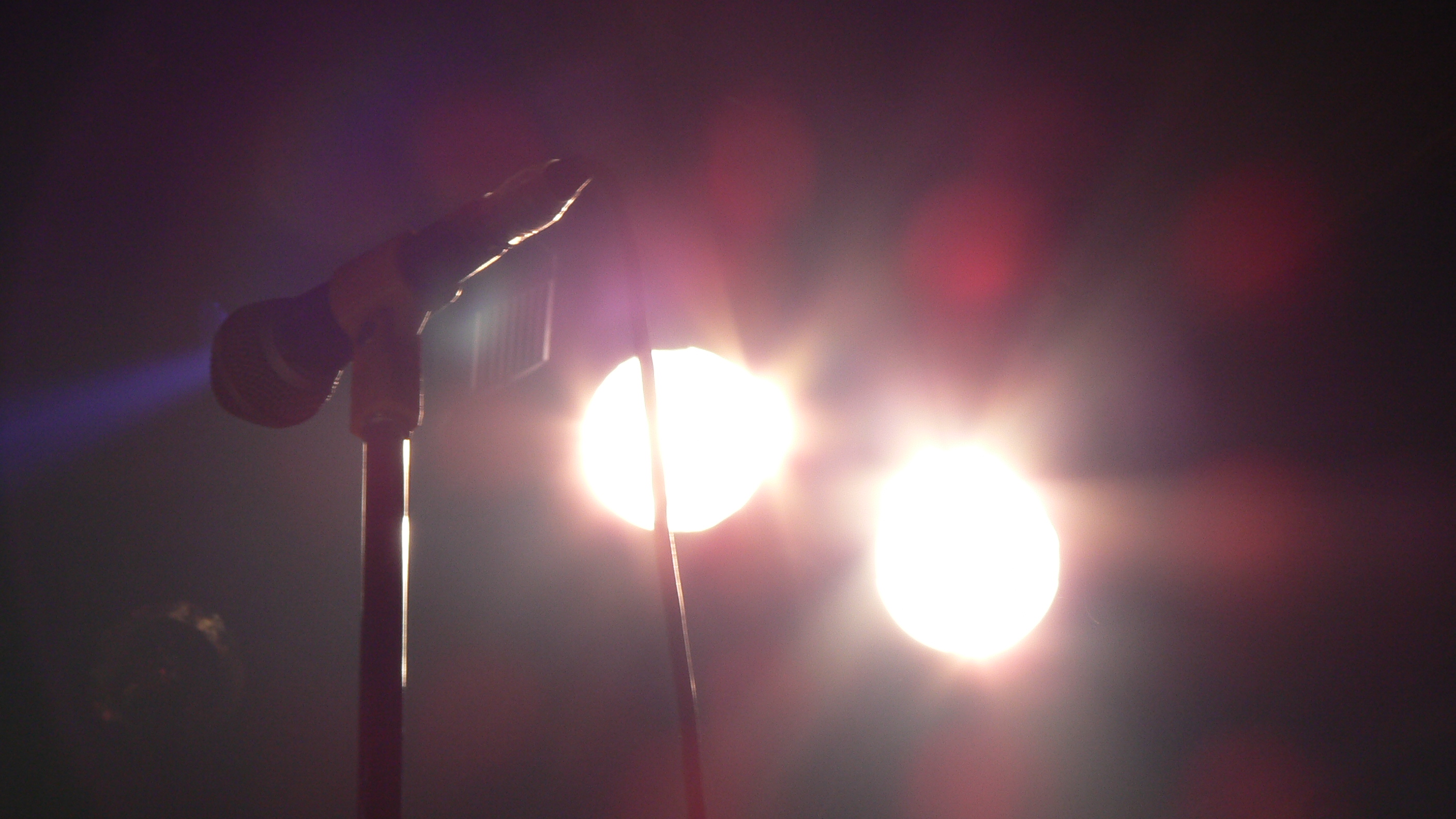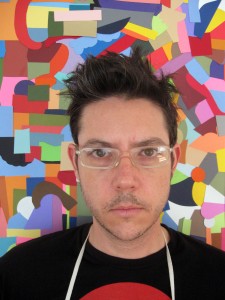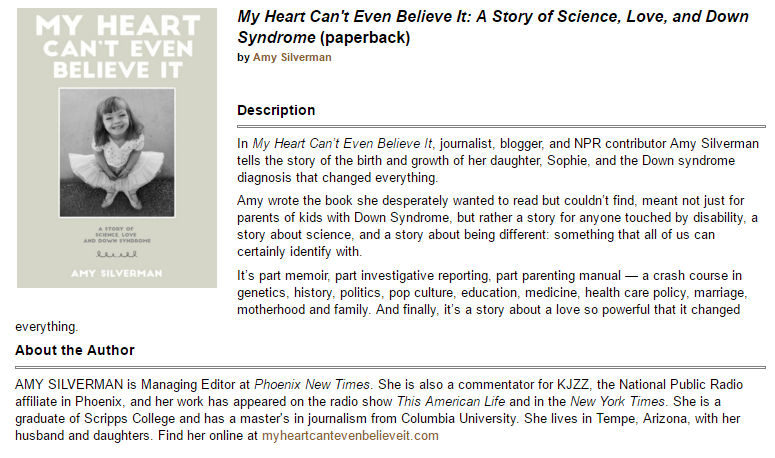Join Amy Silverman to celebrate the launch of her new book, My Heart Can’t Even Believe It: A Story of Science, Love, and Down Syndrome on Sunday, May 1st, from 3pm-5pm at Tempe Changing Hands Bookstore. For tickets to the event and to pre-order the book, visit the Changing Hands website and/or the Facebook event.
New York Times
SR Pod/Vod Series: Writer N. Marc Mullin
Each Tuesday we feature audio or video of an SR Contributor reading their work. Today we’re proud to feature a podcast by N. Marc Mullin.
A native of the Bronx, N. Marc Mullin drove a taxi and spent years as a sheet metal worker before he became an attorney specializing in civil rights and employment law. His short stories have been published in Storyscape Journal, Hawai’i Pacific Review and are forthcoming in the Willow Review and Superstition Review. He published as a finalist in the Middlesex University (UK) international short story contest and he has published nonfiction, including an Op-Ed piece in the New York Times.
You can listen to the podcast on our iTunes Channel.
You can read along with the work in Superstition Review.
Guest Post, Amanda Fields: Youth Slam: Reflections on Research and the Endeavor of Writing

The room is a hot squeeze: words bounce and echo with the clank of mugs, the hiss of steam, the scrape of chairs. On the walls, there is artwork for sale, nailed against galvanized metal sheets or perched on wooden shelves. Behind the counter, a chalkboard menu. This is the kind of coffeehouse that serves organic foods and homemade pies, that hangs up rotating artwork and anti-racism signs. Nestled between a grimy convenience store and a tattoo parlor in central Tucson, its most frequent customers by day seem to be students and professors from the university, or people who make soap to sell at farmers’ markets, or tattooed elites. Once a month, it stays open for this poetry slam, which is regularly packed with high school students from all over southern Arizona, their families, teachers, passersby.
I got here early, and I’m sitting in a corner. I’ve got paper, but I am not, like so many of the young people around me, scribbling inspired lines of poetry or working thumb pads overtime on my phone. Instead of spinning out poems, I am drawing details – the mood, what poets say to each other, what they slam about, how they respond to their scores. I’m writing a dissertation about these poets. It’s a study of youth discourse, art, and activism, and I argue for the poets’ use of rhetorical strategies as suggestive of a specific kind of youth coalition. It’s hard for me to write such words, to work my mouth and ear around academic terms, but this is what I try to do now.
The first time I came to this poetry slam, I didn’t listen. I looked for craft. Pristine lines. I had the MFA ear, so precious. I did not want to hear explicit teen angst. I was with my friend, a writer who is working on a mystery novel. She is a PhD student with three children who supports her family on her own, and she runs at least a dozen miles every morning so she needs to eat constantly – she totes cartons of blueberries and bags of spinach, bagels and nuts.
We are both researchers on a grant that is funding work with local youth organizations, and this poetry slam is one of them. Our interdisciplinary research collective meets in a building on campus that is far from my English department home. This is how far: I was shocked when someone suggested that I could ask for undergraduate help in transcribing and coding my research data, and then I got access to a bright, clean room with a refrigerator where I could place my lunch without admonishment from tenured faculty. In this research collective, we talk about the problems and activism of marginalized Tucson youth who have suffered from increasingly restrictive policies in Arizona, such as the ethnic studies bill, the parents’ bill of rights, and the anti-immigration law. We sit in clean white rooms with bright lights and melodramatic air conditioning and expensive technology. We sit, and we try to figure out how this room squares with all the other spaces of Tucson.
This doesn’t tell you what I am trying to tell you, which is that my friend hears what is beautiful about this space long before I do. That first time, she, also, has brought paper, but, while I listen for gems, she hears the pulse. She nods and furiously writes, transcribing as many lines as she can. We squabble over awarding points because we have been asked to judge. Before the slam, we were handed a binder with scorecards numbering 1-10. At poetry slams, judges are chosen randomly from the audience, and no one is assumed to be an all-knowing critic. Or, everyone is an all-knowing critic because poetry is supposed to be public. After each poem, my friend clutches her heart and wants to give everyone 10’s. I wrinkle my nose frequently and insist upon a lower score, but no lower than 8.5 or we’ll get a big boo from the room. Sometimes she tosses up a 10 before I can object.
The problem with me is that I cannot yet bring myself to be generous, to love what is happening here. Writing has become a cool endeavor. For years, it has been difficult for me to look at my writing, at others’ writing, and be moved. This is not meant to be a quotidian lament about MFA programs, or the “workshop story,” or whatever else is, of late, a concern in creative writing. It is meant to suggest a simple question: how can writing move you (me), again?
Long ago, a New York Times columnist came to my MFA program, read one of my essays, and informed me I could not write a sentence. His pencil crawled over every line. I had felt that my essay was poetic. It had no meaning, no direction, sure, but it was a vivid narrative with comets and cornfields and a school field trip to the planetarium. Look how I’m undermining it. And the way I bowed to that creeping pencil. The way I agreed. The way I said it didn’t bother me while other students were weeping (he had done the same to all of us chosen to work with him). The way I thought my first publication worked because my favorite professor told me it was Chekhovian, and how that was the reason I figured I would submit it somewhere. The way I fool with myself. The way I can shrug at writing I’ve spent days, or years, producing. The way I learned to pause, to sip the sentence, close my eyes, approve of its warmth. And then the way the sipping could dismiss.
A poetry slam is not for sipping. You have to chug. It took a few slams for me to begin to learn how to listen, to be open to what moves these youth poets. There’s as much posturing in professional slam as in “literary” work, but this local slam is a different space. There are so many lines here, less the kind of lines that split than the lines that flow, a river of lines, a cacophony of lines, a supernova. Lines about racial tropes, familial bonds, the ideologies of citizenry, the notion of other. Lines tracing what it means to listen, to be heard, seen, felt. Lines of what it means to be young, genderqueer, gay, brown, white, poor, suburban, defined, confused, certain. Lines that cross, squiggle out past straight, open up the possibility of multifaceted identities, temporal identifications, complex humans. They write these lines before the slam, during the pre-slam workshop, or as the slam unfolds, anticipating their turn, almost-but-not-quite getting cold feet. They come here to write, to listen. They text each other after poems they like, or poems that baffle them; they give each other post-performance hugs. It’s not like the poetry readings of literary treasure. It’s not about “mmmm” or “mmm-hmmm,” the sharp intake of breath at a precious line, the expected silence or pregnant pause that signals we all are wandering in our separate, wooded brains. These lines often call me to reconsider what it means to write and act. They write as if there were no time for anything else, as if their lives were not scrolls just beginning to unfurl.
Forthcoming: Michael Velliquette

What many artists do with paint and canvas and clay Madison-based artist Michael Velliquette does with paper. The results are spectacular. Using strips of brilliantly colored, often hand-painted paper, Velliquette creates complex three dimensional installations that draw the eye with bold geometric shapes and intricate feathered textures. University of Wisconsin’s Lawton Gallery compares his work to the religious symbolism of “a culture devoted to the worship of vivid hues and complex patterning,” while a New York Times article describes it as both “shrinelike” and “reminiscent of party decorations and grade school art projects.” His paper sculptures are deeply evocative of a spiritual experience informed by the tradition of sacred objects, such as masks and icons and totems. Indeed, it is not hard to imagine the installations of his recent exhibit, “ChromaSouls” at the Haggery Museum in Milwaukee as the real idols of a brightly-hued pantheon.
Velliquette’s evocation of sacred relics is all part of his deeper message. While his work does indeed reflect the trans-cultural practice of what he calls “devotional ornamentation,” his paper sculptures are also a direct response to the current cultural and economic environment. Describing his work from 2010-2011, Velliquette states that “In times of crisis, people often turn to religion and faith…As the country was drawing deeper into recession, everything I was hearing in the media was about shortage and scarcity. I wanted my work to express abundance and exuberance, and for the viewer to experience an aesthetic of plenitude.” With its stunning complexity of line, color, shape, and pattern, this is a goal that Velliquette’s work has unarguably achieved.
Read more about Michael Velliquette’s work at Hand Eye Magazine. Visit his website here.
You can purchase the book Lairs of the Unconscious, a survey of Velliquette’s work here.
Superstition Review is thrilled to feature Michael’s work in Issue 8, which will launch in December 2011.

